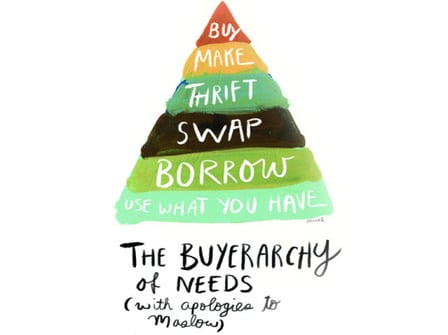Lesson #1: Reflecting on Our Consumption Patterns: How to be a more conscious consumer
(30-35 minutes)

Photo courtesy of Dear Earth People
- Ask students to brainstorm their criteria for what makes a good gift
- Play a clip from this CBC documentary on textile waste in Canada (0:01-5:49, 9:20-9:51)
- After watching the video, facilitate a class discussion using the guiding questions:
- What is your initial reaction to the film clip? How did the content in the clip connect to what you already know or your ideas about textile (or other consumer) waste? What was new information for you? What do you find most challenging about the content in the video clip (or its implications)?
- What tools and strategies do we have to make more conscious and informed purchasing decisions? How can we maintain these tools and strategies throughout the year, long after our "new year's resolutions" have fizzled out?
- What are alternative gifts or purchases we can make during the holiday season that may not include material items?
- Ask students to revisit and refine their criteria for what makes a good gift using ideas that surfaced from the video.
- Create a Holiday Mission Statement (in list form) with your students outlining 5-10 things they will try to do this holiday season, and in their lives, to be more conscious consumers. For example:
- Making a commitment to be environmentally conscious
- Looking for fair-trade gifts or items that pay fair wages to workers
- Avoiding single use and throw-away items
- Purchasing gifts that help support a good cause
Lesson #2: The Power of Choices X WestJet
(40-45 minutes)

This WestJet holiday commercial made us think about the sacrifices we choose to make to provide opportunities to others. Especially during the holiday season, we confront our responsibilities to our ourselves, our friends and families, and our communities. This commercial inspired this short lesson on empathy, selflessness, altruism, choice, generosity and the way we value relationships.
- Paint a picture for your students- you enter into a school-wide draw to win 20 free lunches from your favourite restaurant. Congratulations! You win the draw and your teacher tells you that you can either keep the full prize for yourself, keep half and donate half, or donate the full prize to homeless youth in the city. What do you do?
- Anonymous fish bowl: Hand out small pieces of paper. Instruct students to write down whether they will (1) keep the full prize for themselves or (2) give the full prize away to someone in need or (3) keep half of the prize and give away half of the prize. Students must write 1 sentence explaining their decision. Remind students that their responses will be read aloud to the class anonymously.
- Collect all of the anonymous responses and if your room permits, move students into a circle. Read out the responses and have a short discussion afterwards:
- Was it easy to decide what to do?
- Are you surprised by your classmates responses?
- Do you think people's choices differ because of their specific circumstances? Why or why not?
- Show students the WestJet holiday commercial which shows families choosing between keeping a WestJet holiday package for themselves or donating the trip to families from the Ronald McDonald House
- Lead a class discussion using the following guiding questions:
- How do you think people made their choices?
- Why do you think parents often looked to their children when making the decision?
- Keeping or giving away- Is there a right or wrong answer?
- Do you think people's answers may change if the cameras were not there?
- Choosing to Participate
- Invite students to select a charity or organization they would like to donate time, a hand-made gift or card, or money toward.
- Invite students to select a charity or organization they would like to donate time, a hand-made gift or card, or money toward.

